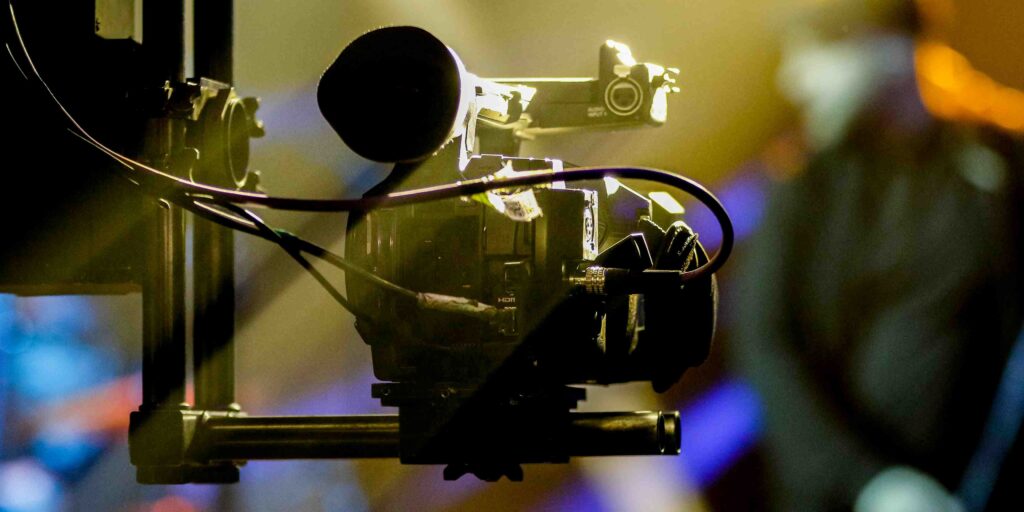 April 23, 2023 by thilina |
live web streaming
April 23, 2023 by thilina |
live web streamingIntroduction to Live Web Streaming and What It Can Do for Your Business
Live streaming is an excellent way for businesses to increase their reach, grow their audience, and maximize engagement. With the right equipment and professional production services, you can deliver engaging content in real-time from anywhere in the world. In addition to its interactive nature, live streaming provides cost-effective solutions for marketing campaigns, product launches, demonstrations, and more. Live web streaming also allows businesses to save time by quickly broadcasting messages or updates compared with traditional methods of communication such as newspapers or radio broadcasts.
The Benefits of Utilising a Professional Production Service for Live Web Streaming

When it comes to live web streaming production services, professionals are able to leverage years of expertise in order to provide high-quality results. By hiring a professional service provider that specialises in live streaming technology, businesses can rest assured knowing the audio-visual elements will be taken care of properly so they can focus on delivering engaging content while avoiding technical mishaps during broadcasts. A reliable production service should also have access to up-to-date technology that adheres to industry standards when it comes to broadcasting solution compatibility across multiple platforms, including Youtube Live Streaming and Twitch TV channels, etc., allowing businesses to access a wide range of potential viewers virtually anywhere, regardless of internet speed or device compatibility. In addition, professional production services often provide comprehensive post-production services for archiving and retention purposes following broadcasting, which gives businesses the opportunity to repurpose their content in other ways such as VOD (video on demand) offerings or with edited clips.
Steps to Take When Getting Started With Live Web Streaming
The first step towards getting started with live streaming is familiarising yourself with the process from start to finish. It’s important that you understand how equipment works together in order to achieve desired results. Early preparation will help avoid technical issues down the road during broadcasts. Additionally, it’s a good idea to research your target audience so that you can craft engaging stories that relate directly to them and make them excited about tuning into your broadcast.
Choosing the Right Equipment for Your Needs
When selecting equipment for live web streaming, it’s important to consider factors such as budget, space available for setup, and production capabilities needed, among other things. Many times, businesses may opt for an all-in-one solution where they get everything they need, including cameras, lighting rigs, audio mixers, and more, in one package. However, if budget is not a factor, there are many individual components available within the market that offer great flexibility in terms of production capabilities.
Tips for Optimising Your Live Stream Quality

Optimizing your live stream quality can make a big difference when it comes to delivering engaging content. Firstly, you should consider investing in higher bandwidth if possible and ensure that your streaming computer has sufficient memory and processing speeds to allow for smooth broadcasting. Additionally, make sure that audio levels are balanced, as loud background noise can greatly affect the viewer experience. Utilising a backup connection such as cellular network is also a good way to guarantee seamless broadcasting even when main sources suffer from outages or interference issues. Finally, use high-quality cameras with good zooming capabilities so viewers don’t miss any small details during broadcasts.
How to Monetize Your Live Stream
There are various ways to monetize live stream, but the most popular one is through advertising revenue and sponsorships. Advertising revenue involves inserting commercials or product placements within livestream, while sponsorship revenue involves partnering with companies who have an interest in reaching out to your target demographic using their brand messaging or event promotions within broadcasts. It’s important to note that monetization efforts often require specific agreements from rights holders depending on what type of material will be streamed. Be aware of local laws that may affect your ability to monetize material you don’t own the rights to.
Best Practises for Engaging Audiences During A Livestream Event
Engaging audiences during a livestream event can be tricky, as people tend to lose focus quickly unless they find the content exciting or relevant. Therefore, it’s important to consider how you plan on engaging viewers and keeping them entertained throughout each broadcast. Start by introducing yourself or your company and clearly explaining what viewers can expect from watching your stream while teasing exclusive information that will keep them coming back for more. It’s also a good idea to create polls and questions asking viewers for their opinions on specific topics related to broadcasts in order to gauge engagement and give audience members additional ways of expressing themselves interactively.
Troubleshooting Common Issues During Livestream Events
3D virtual studio sets are the perfect solution for businesses looking to create more engaging and professional-looking livestream events without having time or money for physical studio rentals. Utilising 3D virtual sets can provide realistic backgrounds with complex effects such as lighting and shadows, which can be easily controlled from within the comfort of your own home or office, providing immense cost savings compared with traditional methods. Additionally, it eliminates long setup times associated with using physical studios, as most scenes are ready to broadcast almost immediately after loading them up on hardware.
Exploring Innovative Ways to Improve Your Live Stream Content Quality
Live streaming is all about entertaining viewers, so it’s important that you make sure content quality is always improving over time in order to keep people coming back. One way to do this is by investing less in equipment and more in post-production services like editing and colour grading if needed; this will give stream a much more polished look and feel compared to basic, unedited live broadcasts, which tend to get quite stale over time. Additionally, it’s important to have a strategy in place for handling audio and video issues when they occur during broadcasts. Utilising real-time monitoring tools can help you quickly identify any potential problems and address them without impacting viewership.
FAQs:
Professional production services typically provide comprehensive solutions for live streaming, including setup, testing, troubleshooting, and post-production editing, depending on the needs of businesses that hire their service offerings. From basic webcasting all the way up to complex event productions, most professional production companies should be able to provide specific solution packages tailored towards individual projects with relative ease.
One way to maximise your livestream’s reach is by utilising multiple platforms, such as YouTube live stream and Twitch TV channels, among many others. By doing this, you would increase your potential audience drastically since different viewers may prefer one platform over another due to availability or preference between designs, etc. It’s also important that you promote your livestream events through various marketing channels like email lists, social media outreach campaigns, etc., using engaging stories prior to each broadcast, which will increase viewership and amplify overall reach.
This ultimately depends on the type of production you are doing and what your overall goals are when it comes to streaming. Pre-recorded content is great if you are looking to show off a product or demonstrate its capabilities without needing real-time interaction from viewers; however, some events may be better suited with live feeds instead, such as Q&A sessions with celebrities or interviews, etc. It’s important that you properly weigh out the pros and cons in order to arrive at the best decision for your specific project needs.
Live streaming costs can vary depending on the size of each event, the professional services utilised, the quality of the equipment, etc. On average, most basic webcasting solutions should range between $500 and $2,000 per event, while complex productions can easily go up into the tens of thousands or more depending on specific needs. Cost savings can usually be achieved by utilising existing equipment and hiring external solutions whenever possible until budgets allow otherwise.
Yes. Depending on how technical we get, there are multiple streaming protocols, resolution settings, and encoding options available depending on individual project requirements, but the most common solutions involve using RTMP (Real Time Messaging Protocol) with either H.264 or H.265 codecs to achieve desired video quality results within reasonable file sizes while providing good playback performance across various platforms.
There’s a multitude of different software packages available, ranging from free open-source programmes all the way up to enterprise-grade offerings. It is important that you select software that matches your budget and specific production needs since some solutions provide more features than others, such as multi-camera switching, overlays, etc. Some popular software used in professional production circuits includes vMix, Tele stream Wirecast, and Adobe Flash Media Live Encoder, among many others.
Yes. Depending on the content streamed or shared via live broadcasts, there may be certain laws that can restrict or limit what viewers become exposed to, especially in regards to minors who may view inappropriate material unintentionally during streaming. Additionally, businesses must protect themselves legally by ensuring each stream is broadcast following specific guidelines established by local and country laws; failure to do so can result in hefty fines or even jail time depending on the severity of violations.
Safety is paramount when it comes to live stream, as personal data can be captured and shared easily across multiple devices with little effort. It’s important that you use authentication to secure access, either through login credentials such as usernames and passwords or two-factor identification like mobile SMS codes, etc. Additionally, ensure that any sensitive information is removed from broadcasts after each stream has ended to minimise potential liability. Lastly, keep backups of all recorded content offsite in case something happens and you need a copy for legal purposes later down the road.
There are many ways businesses can improve their streaming experiences, but some of the most popular ones involve using multiple camera angles during broadcasts, adding interactive elements like polls and surveys, or utilising various overlays such as lower thirds, which will add an extra flair to your productions while helping viewers instantly identify key figures within broadcasted events without having everyone speak individually. Professional production services typically also provide a wealth of additional features ranging from custom graphic design to chroma key compositing, depending on individual project needs.
Yes. Because livestreaming are real-time events, there’s a multitude of ways you can measure success depending on specific goals desired. Tracking metrics such as viewership numbers, time watched, and exclusive content shared, among other factors, can provide invaluable insights as to whether campaigns have been a success or not, while also allowing businesses the opportunity to adjust strategies accordingly in order to increase overall ROI (return on investment).
